Test Overview
1. A Single A100 40GB GPU Details(with NVLink):
- GPU: Nvidia A100
- Microarchitecture: Ampere
- Compute capability: 8.0
- CUDA Cores: 6912
- Tensor Cores: 432
- Memory: 40GB HBM2
- FP32 performance: 19.5 TFLOPS
2. Test Project Code Source:
- We used this git project to build the environment(https://github.com/vllm-project/vllm)
3. The Following Models from Hugging Face were Tested:
- google/gemma-3-12b-it
- google/gemma-3-27b-it
- meta-llama/Llama-3.1-8B-Instruct
- deepseek-ai/DeepSeek-R1-Distill-Qwen-14B
- deepseek-ai/DeepSeek-R1-Distill-Qwen-32B
- Qwen/QwQ-32B
4. The Test Parameters are Preset as Follows:
- Input length: 100 tokens
- Output length: 600 tokens
- --tensor-parallel-size 2
- --max-model-len 4096
5. We conducted two rounds of 2*A100 vLLM tests under different concurrent request loads:
- Scenario 1: 50 concurrent requests
- Scenario 2: 100 concurrent requests
2*A100 Benchmark for Scenario 1: 50 Concurrent Requests
| Models | google/gemma-3-12b-it | google/gemma-3-27b-it | meta-llama/Llama-3.1-8B-Instruct | deepseek-ai/DeepSeek-R1-Distill-Qwen-14B | deepseek-ai/DeepSeek-R1-Distill-Qwen-32B | Qwen/QwQ-32B |
|---|---|---|---|---|---|---|
| Quantization | 16 | 16 | 16 | 16 | 16 | 16 |
| Size(GB) | 23 | 51 | 15 | 28 | 62 | 62 |
| Backend/Platform | vLLM | vLLM | vLLM | vLLM | vLLM | vLLM |
| Request Numbers | 50 | 50 | 50 | 50 | 50 | 50 |
| Benchmark Duration(s) | 12.97 | 22.77 | 7.28 | 11.60 | 29.16 | 33.39 |
| Total Input Tokens | 5000 | 5000 | 5000 | 5000 | 5000 | 5000 |
| Total Generated Tokens | 27004 | 23052 | 22103 | 17528 | 22393 | 27584 |
| Request (req/s) | 3.86 | 2.20 | 6.87 | 4.31 | 1.71 | 1.50 |
| Input (tokens/s) | 385.61 | 219.59 | 687.19 | 430.91 | 171.45 | 149.74 |
| Output (tokens/s) | 2082.65 | 1012.40 | 3037.77 | 1510.59 | 767.89 | 826.03 |
| Total Throughput (tokens/s) | 2468.26 | 1231.99 | 3724.96 | 1941.50 | 939.34 | 975.77 |
| Median TTFT (ms) | 128.42 | 710.96 | 206.38 | 386.49 | 783.65 | 785.46 |
| P99 TTFT (ms) | 154.23 | 888.83 | 307.44 | 524.14 | 1006.79 | 1003.58 |
| Median TPOT (ms) | 21.37 | 34.97 | 11.70 | 18.70 | 36.59 | 36.77 |
| P99 TPOT (ms) | 22.48 | 215.47 | 15.78 | 29.99 | 53.03 | 53.96 |
| Median Eval Rate (tokens/s) | 46.79 | 28.60 | 85.47 | 53.48 | 27.33 | 27.20 |
| P99 Eval Rate (tokens/s) | 44.48 | 4.64 | 63.37 | 33.34 | 36.59 | 18.53 |
✅ Key Takeaways:
- 8B models (Llama-3) dominate in speed (~3.7K tokens/s). Gemma-3-12B performs well (~2.4K tokens/s, low TTFT). 32B models (DeepSeek, Qwen) are usable but slower (~1K tokens/s).
- Even at 50 concurrent requests, models up to 32B run smoothly without hitting performance ceilings.
2*A100 Benchmark for Scenario 2: 100 Concurrent Requests
| Models | google/gemma-3-12b-it | google/gemma-3-27b-it | meta-llama/Llama-3.1-8B-Instruct | deepseek-ai/DeepSeek-R1-Distill-Qwen-14B | deepseek-ai/DeepSeek-R1-Distill-Qwen-32B | Qwen/QwQ-32B |
|---|---|---|---|---|---|---|
| Quantization | 16 | 16 | 16 | 16 | 16 | 16 |
| Size(GB) | 23 | 51 | 15 | 28 | 62 | 62 |
| Backend/Platform | vLLM | vLLM | vLLM | vLLM | vLLM | vLLM |
| Request Numbers | 100 | 100 | 100 | 100 | 100 | 100 |
| Benchmark Duration(s) | 17.79 | 41.23 | 9.39 | 13.13 | 47.30 | 60.46 |
| Total Input Tokens | 10000 | 10000 | 10000 | 10000 | 10000 | 10000 |
| Total Generated Tokens | 49724 | 45682 | 47902 | 37764 | 44613 | 56858 |
| Request (req/s) | 5.62 | 2.43 | 10.65 | 7.62 | 2.11 | 1.65 |
| Input (tokens/s) | 561.97 | 242.55 | 1065.37 | 761.66 | 211.43 | 165.4 |
| Output (tokens/s) | 2794.32 | 1108.03 | 5103.34 | 2876.36 | 943.22 | 940.42 |
| Total Throughput (tokens/s) | 3356.29 | 1350.58 | 6168.71 | 3638.02 | 1154.65 | 1105.82 |
| Median TTFT (ms) | 541.36 | 651.69 | 215.63 | 272.59 | 865.14 | 872.33 |
| P99 TTFT (ms) | 873.22 | 1274.52 | 432.56 | 654.96 | 1666.14 | 1652.29 |
| Median TPOT (ms) | 28.66 | 49.01 | 15.21 | 21.45 | 54.91 | 66.68 |
| P99 TPOT (ms) | 146.27 | 325.90 | 21.52 | 38.99 | 181.85 | 102.40 |
| Median Eval Rate (tokens/s) | 34.89 | 20.40 | 65.75 | 46.62 | 18.21 | 14.99 |
| P99 Eval Rate (tokens/s) | 6.84 | 3.07 | 46.47 | 25.65 | 5.50 | 9.77 |
✅ Key Takeaways:
- Throughput scales almost linearly (Llama-3 8b hits 6K tokens/s). 14B-32B models remain stable—no latency spikes at 100 reqs.
- Gemma-3-12B runs smoothly (3.3K tokens/s), proving multi-GPU efficiency.
- Even at 100 requests, throughput continues to increase and latency remains low, confirming no bottleneck—this system can likely handle 200+ concurrent inferences.
Why Dual A100 40GB Is the Best Fit for 14B–32B Models
✅ Perfect Match for Multi-modal Giants
Models like Gemma-3-27B and Qwen-32B are multi-modal and memory-intensive. They simply cannot run reliably on GPUs with less than 80GB combined VRAM. A dual-A100 setup solves this.
✅ NVLink & Tensor Parallelism Matter
Always use --tensor-parallel-size 2 to fully utilize both A100 processors, take advantage of NVLink for faster inter-GPU communication, and avoid using pipeline parallelism unless absolutely necessary; tensor parallelism enables lower latency and higher throughput.
Operational Tips & Cautions
⚠️ -max-model-len 4096 or 8192
For models like Qwen-32B and DeepSeek-32B, always set: --max-model-len 4096. Otherwise, you may encounter out-of-memory or shape mismatch errors.
⚠️ GPU Temperatures
Watch GPU Temperatures: At 100+ concurrent requests, GPU temp may exceed 80°C. Tip: Use nvitop + manual fan boost for 5 minutes if temp exceeds 80°C.
Get Started with 2*A100 GPU Server Hosting
Interested in optimizing your LLM deployment? Check out GPU server rental services or explore alternative GPUs for high-end AI inference.
Flash Sale to May 27
Enterprise GPU Dedicated Server - A100
$ 469.00/mo
41% OFF Recurring (Was $799.00)
1mo3mo12mo24mo
Order Now- 256GB RAM
- Dual 18-Core E5-2697v4
- 240GB SSD + 2TB NVMe + 8TB SATA
- 100Mbps-1Gbps
- OS: Windows / Linux
- GPU: Nvidia A100
- Microarchitecture: Ampere
- CUDA Cores: 6912
- Tensor Cores: 432
- GPU Memory: 40GB HBM2
- FP32 Performance: 19.5 TFLOPS
- Good alternativeto A800, H100, H800, L40. Support FP64 precision computation, large-scale inference/AI training/ML.etc
Multi-GPU Dedicated Server - 2xA100
$ 1099.00/mo
1mo3mo12mo24mo
Order Now- 256GB RAM
- Dual 18-Core E5-2697v4
- 240GB SSD + 2TB NVMe + 8TB SATA
- 1Gbps
- OS: Windows / Linux
- GPU: Nvidia A100
- Microarchitecture: Ampere
- CUDA Cores: 6912
- Tensor Cores: 432
- GPU Memory: 40GB HBM2
- FP32 Performance: 19.5 TFLOPS
- Free NVLink Included
- A Powerful Dual-GPU Solution for Demanding AI Workloads, Large-Scale Inference, ML Training.etc. A cost-effective alternative to A100 80GB and H100, delivering exceptional performance at a competitive price.
New Arrival
Enterprise GPU Dedicated Server - A100(80GB)
$ 1559.00/mo
1mo3mo12mo24mo
Order Now- 256GB RAM
- Dual 18-Core E5-2697v4
- 240GB SSD + 2TB NVMe + 8TB SATA
- 100Mbps-1Gbps
- OS: Windows / Linux
- GPU: Nvidia A100
- Microarchitecture: Ampere
- CUDA Cores: 6912
- Tensor Cores: 432
- GPU Memory: 80GB HBM2e
- FP32 Performance: 19.5 TFLOPS
Enterprise GPU Dedicated Server - H100
$ 2099.00/mo
1mo3mo12mo24mo
Order Now- 256GB RAM
- Dual 18-Core E5-2697v4
- 240GB SSD + 2TB NVMe + 8TB SATA
- 100Mbps-1Gbps
- OS: Windows / Linux
- GPU: Nvidia H100
- Microarchitecture: Hopper
- CUDA Cores: 14,592
- Tensor Cores: 456
- GPU Memory: 80GB HBM2e
- FP32 Performance: 183TFLOPS
Conclusion: Dual A100 (Total 80GB) Is the Production-Ready Workhorse for 14B–32B LLMs
Dual A100 40GB GPUs (with NVLink) are an excellent choice for 14B-32B models, including Gemma-3-27B, achieving 3K-6K tokens/s at 100+ requests.
- For startups & researchers: Cost-effective alternative to H100.
- For enterprises: Stable for 200-300 concurrent users (no bottleneck detected).
- Always use --tensor-parallel-size 2 for maximum throughput!
For ultra-large models (70B+), consider 2* H100, 2*A100 80GB or 4*A100 40GB, but 2×A100 40GB is perfect for 32B and below.
Attachment: Video Recording of 2*A100 vLLM Benchmark
Screenshot: 2*A100 40GB vLLM benchmark with 50 Concurrent Requests
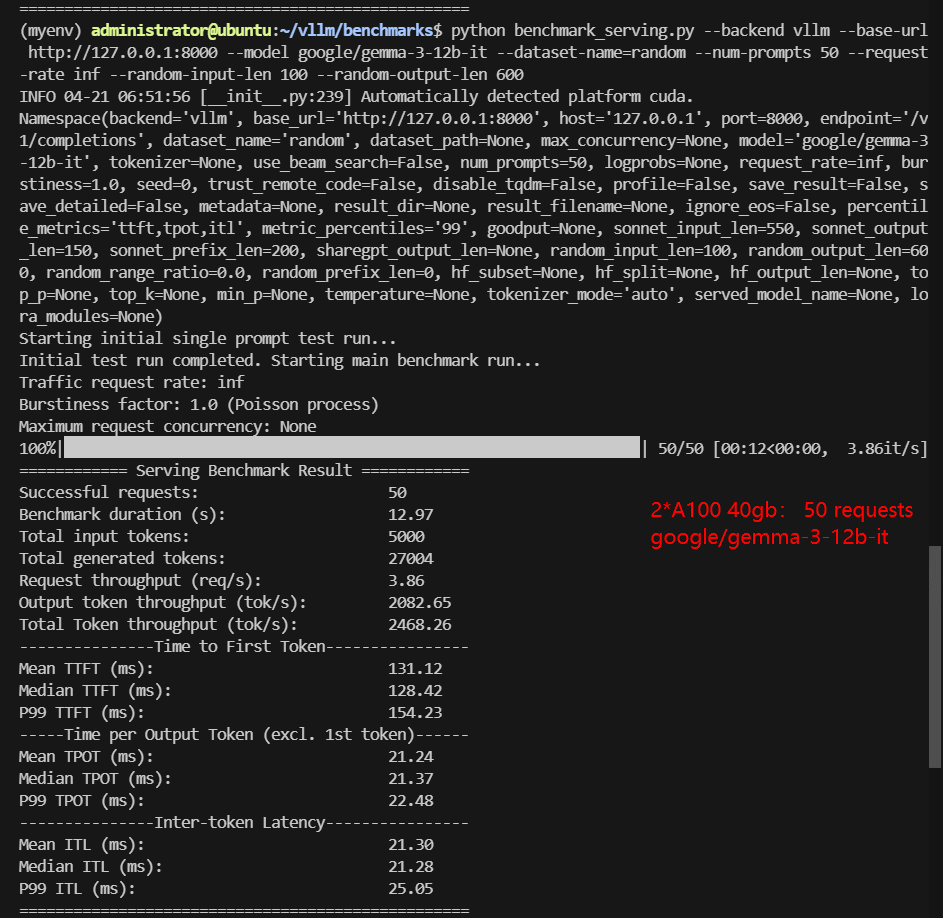
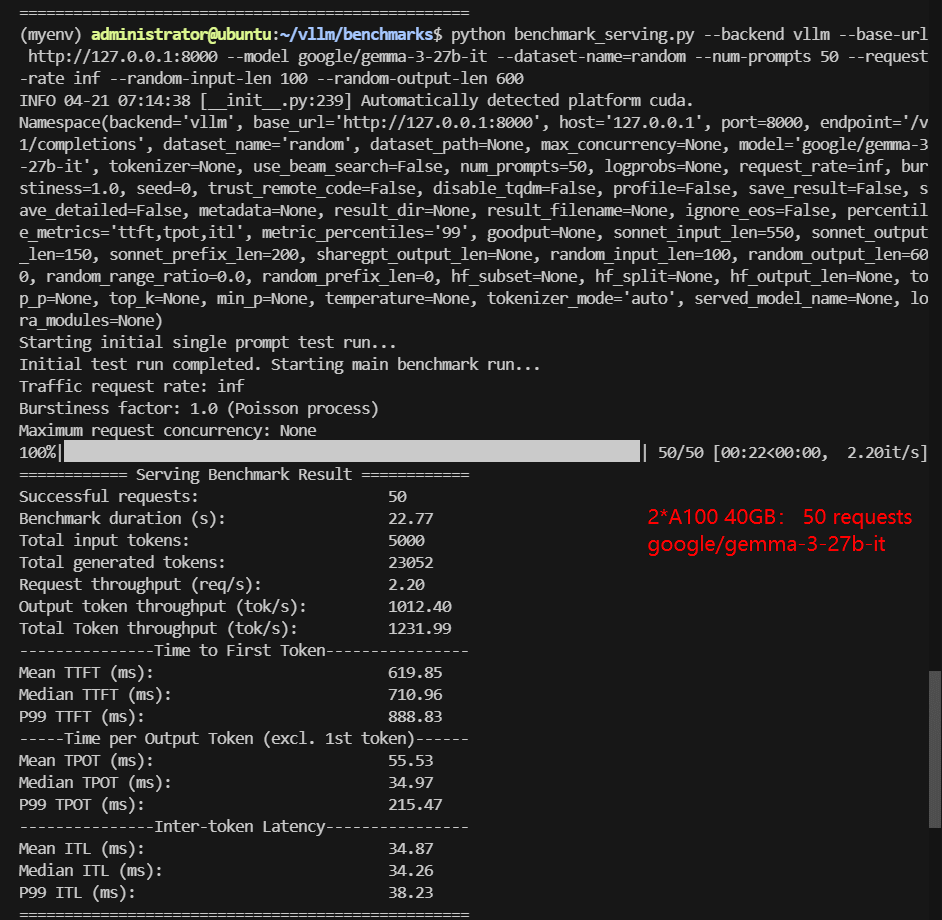
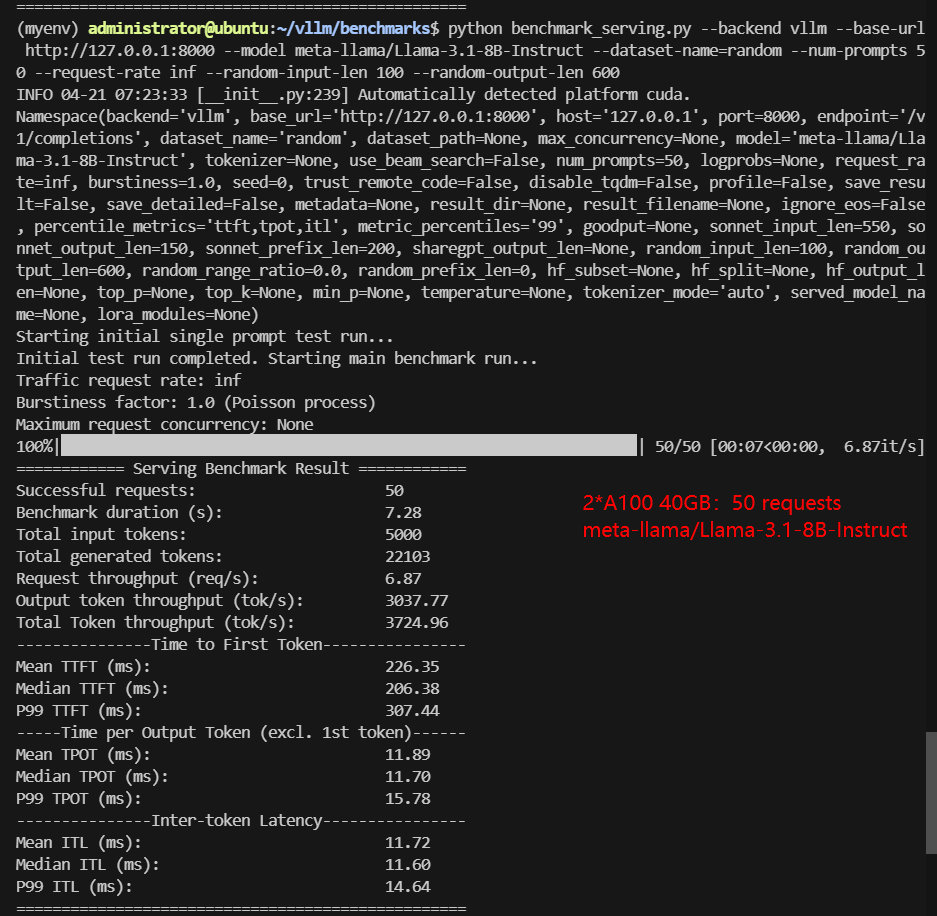
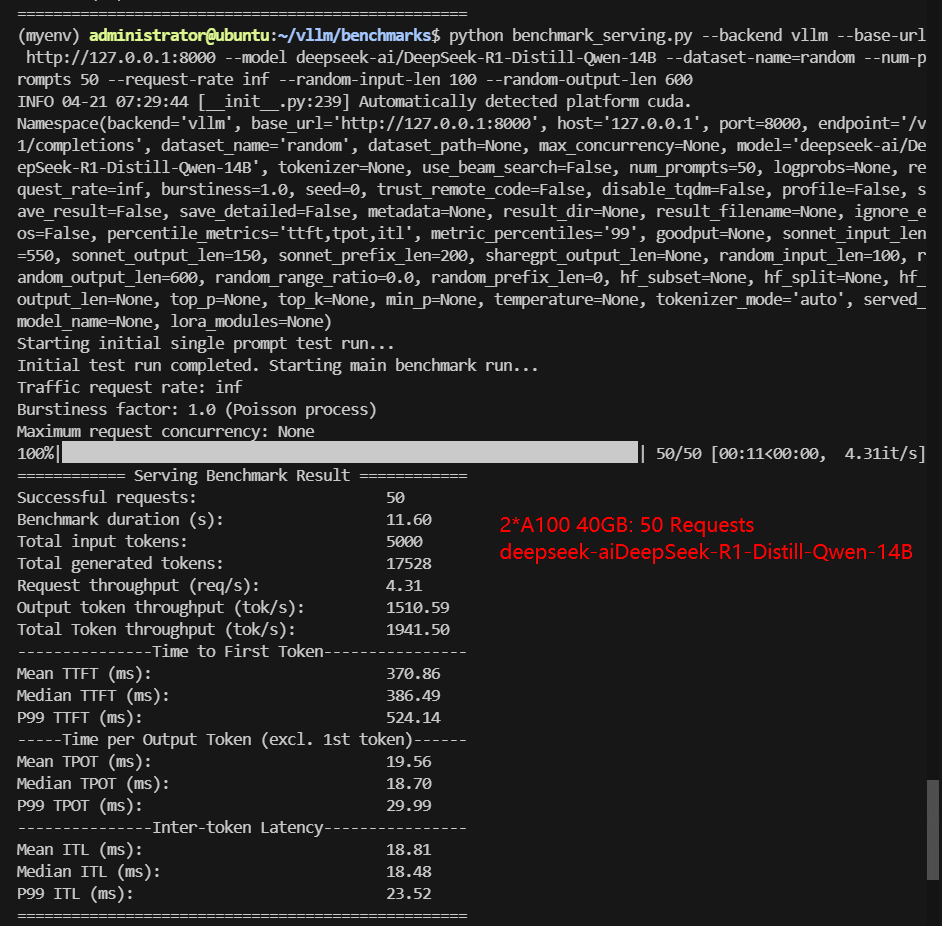
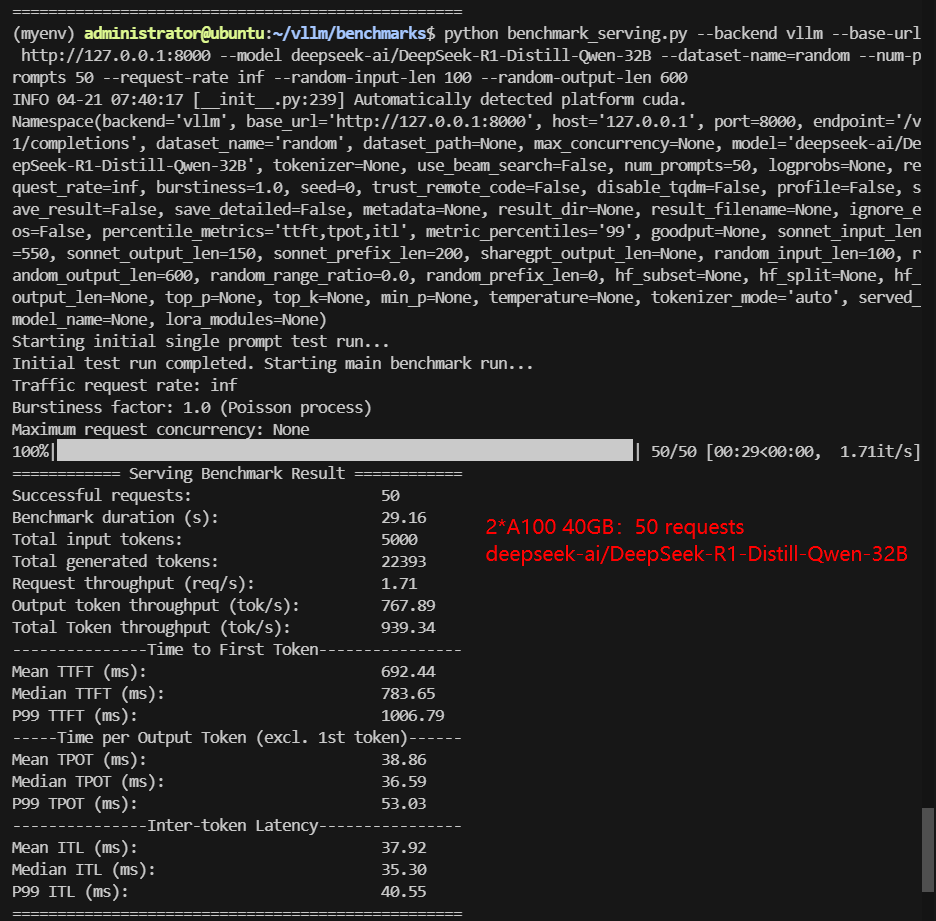
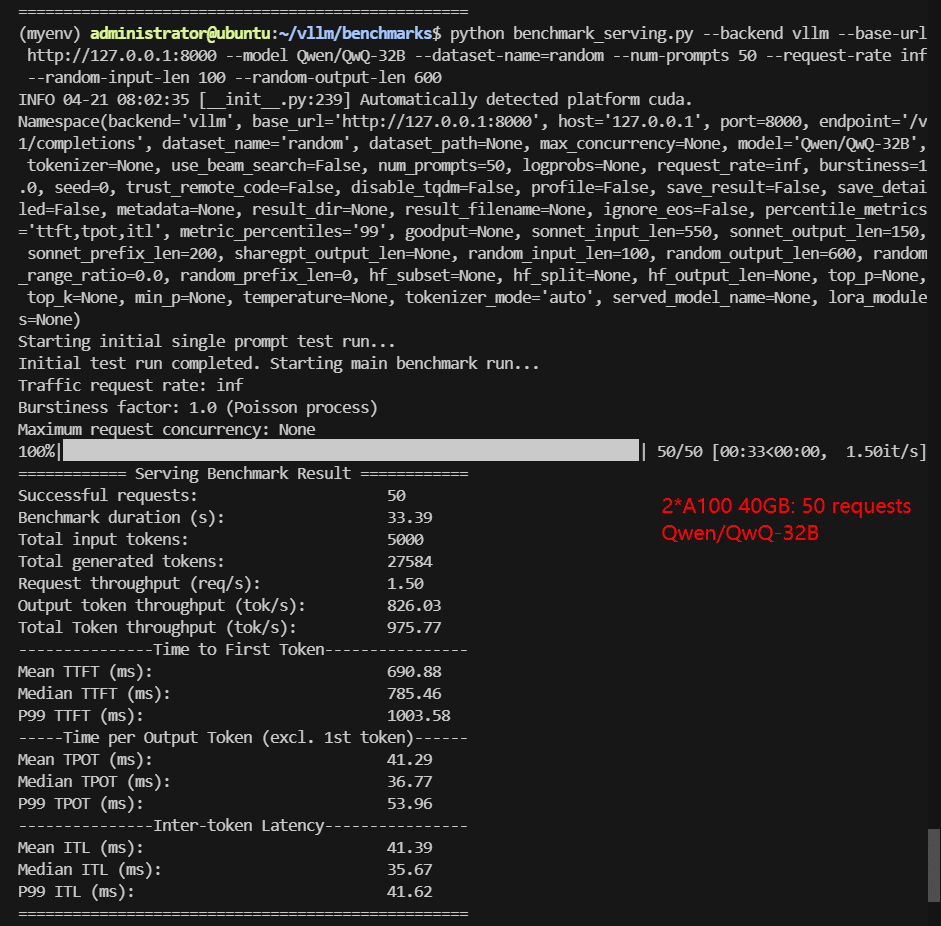
Screenshot: 2*A100 40GB vLLM benchmark with 100 Concurrent Requests






Data Item Explanation in the Table:
- Quantization: The number of quantization bits. This test uses 16 bits, a full-blooded model.
- Size(GB): Model size in GB.
- Backend: The inference backend used. In this test, vLLM is used.
- Successful Requests: The number of requests processed.
- Benchmark duration(s): The total time to complete all requests.
- Total input tokens: The total number of input tokens across all requests.
- Total generated tokens: The total number of output tokens generated across all requests.
- Request (req/s): The number of requests processed per second.
- Input (tokens/s): The number of input tokens processed per second.
- Output (tokens/s): The number of output tokens generated per second.
- Total Throughput (tokens/s): The total number of tokens processed per second (input + output).
- Median TTFT(ms): The time from when the request is made to when the first token is received, in milliseconds. A lower TTFT means that the user is able to get a response faster.
- P99 TTFT (ms): The 99th percentile Time to First Token, representing the worst-case latency for 99% of requests—lower is better to ensure consistent performance.
- Median TPOT(ms): The time required to generate each output token, in milliseconds. A lower TPOT indicates that the system is able to generate a complete response faster.
- P99 TPOT (ms): The 99th percentile Time Per Output Token, showing the worst-case delay in token generation—lower is better to minimize response variability.
- Median Eval Rate(tokens/s): The number of tokens evaluated per second per user. A high evaluation rate indicates that the system is able to serve each user efficiently.
- P99 Eval Rate(tokens/s): The number of tokens evaluated per second by the 99th percentile user represents the worst user experience.
Tags:
Dual A100 vLLM Benchmark, 2x A100 40GB LLM Hosting, Hugging Face 32B Inference, Multi-GPU vLLM Benchmark, tensor-parallel-size 2 benchmark,VInfer gemma-3 on A100, Qwen 32B GPU requirements, A100 vs H100 for LLMs, Best GPU for 32B LLM inference, Hosting 14B–32B LLMs on vLLM























